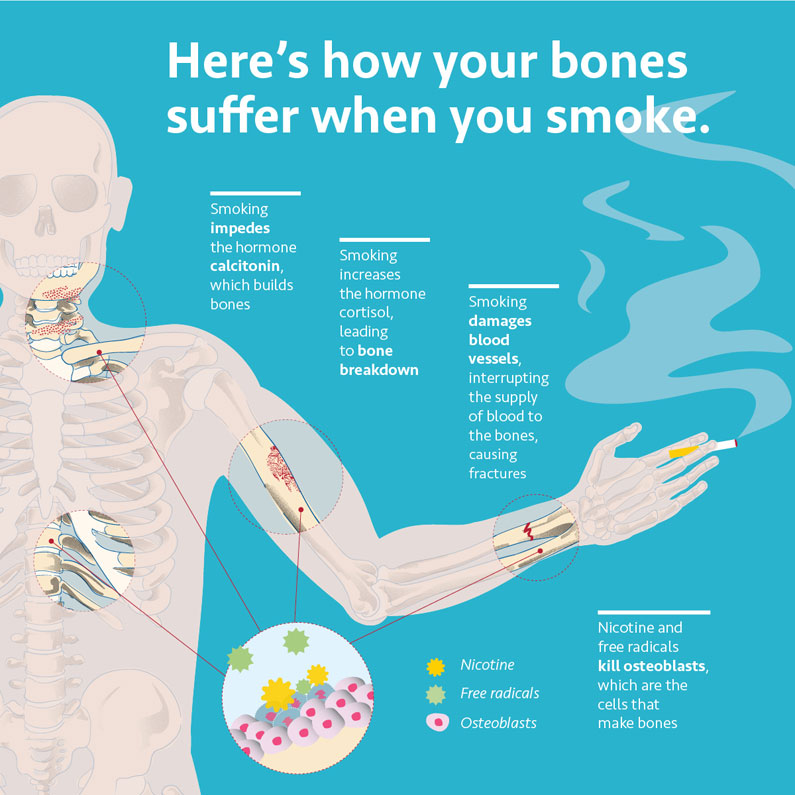What smoking does to your bones

Smoking is, indisputably, the leading preventable cause of death in the United States and world because it causes heart disease, lung cancer, stroke and emphysema, and it contributes to a host of other debilitating conditions.
Tobacco smoking is also bad for your bones, says UCI Health orthopaedic surgeon Russell Stitzlein, MD. It makes you prone to osteoporosis and bone fractures, and more likely to heal slowly from musculoskeletal injuries.
How smoking affects bones
Stitzlein, an assistant professor and chief of orthopedic oncology in the UCI School of Medicine’s Department of Orthopaedic Surgery, explains several ways smoking weakens bones:
- Smoking reduces the blood supply to the bones and to many other body tissues.
- The nicotine in cigarettes slows production of bone-producing cells, called osteoblasts.
- Smoking decreases the body’s absorption of calcium, which is necessary for vital cellular functions and bone health.
- Smoking affects the balance of hormones, including estrogen, which is needed to build and maintain a strong skeleton in women and men.
Fewer people smoke but health cost remains high
Smoking continues to decline in the United States, down from 20.9 percent of adults in 2005 to 15.5 percent in 2016 — for a total of 37.8 million people — according to the Centers for Disease Control and Prevention.
But the cost in illness and death remains substantial. One in five deaths — over 480,000 a year — is related to smoking, and more than 16 million Americans live with a smoking-related disease.
Studies estimate the annual economic cost at over $300 billion a year — nearly $170 billion in direct medical care and over $156 billion in lost productivity.

Hip fractures higher among smokers
Take just one alarming example of the damage smoking can do:
“The American Academy of Orthopaedic Surgeons reports evidence that smokers older than 65 are 30 percent to 40 percent more likely to break their hips,” Stitzlein says. “And hip fracture mortality is 25 to 30 percent at one year.
“Quitting smoking is the number one thing you can do to protect your bones, and it will help slow down loss of bone density,” he says. “Certain medications can also help slow the decline.”
Rebuilding bone density, however, is difficult. “By age 25 to 30, people have reached their maximum bone density, and it’s downhill from there,” he says.
Improving bone health
Beyond quitting smoking, Stitzlein advises strengthening and protecting your bones with the following:
- Exercising regularly — walking, climbing stairs, weight training or dancing — encourages healthy bone replacement. Just don’t overdo it to the point where your body becomes malnourished.
- Eat a diet rich in calcium, which can be found in leafy green vegetables, low-fat dairy products and calcium-fortified foods and beverages. Take supplements, if you’re not getting the recommended daily amounts of calcium — 1,000 mg for men and women up to age 50, and 1,200 mg for women over 50 and men over 70, according to the National Academy of Medicine.
- Get enough vitamin D, which the body needs to absorb calcium. The body makes vitamin D from exposure to sunlight — not much of a problem in Southern California — but you can also get it from foods like egg yolks, saltwater fish and liver. Supplements may be needed to get the recommended 600 to 800 IU/day for adults.
- Avoid excessive alcohol consumption, which can interfere with the absorption of calcium and vitamin D.
- Talk with your doctor about getting a bone density test.
The benefits of quitting
But giving up smoking is essential.
“I really cannot emphasize enough that quitting smoking is the best thing you can do for your overall health,” Stitzlein says.
“In addition to benefitting your bone and musculoskeletal health, quitting will reduce your risk of heart and lung diseases, cancer and so many other smoking-related conditions.”




